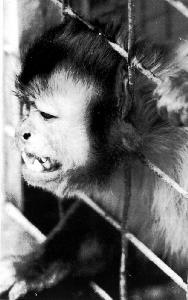| Home Page
City of Plymouth Animal Welfare Charter
Links
Choose Cruelty-free in Plymouth
Vivisection
Farmed Animals
Bloodsports
Animals in 'entertainment'
Dairy Products and Eggs
Campaigns in Plymouth
|
|
Zoos
Space in zoos rarely, if ever, matches the animals' natural range, and more commonly is reduced instead to virtually nothing. Animals which would naturally roam for tens of miles a day tread the same few paces daily. Some of the fastest animals on earth live in pens so small that they could not gather pace to a trot, let alone full speed.
Giraffes, which drift gracefully above the trees in Africa, in the zoo become awkward looking freaks in a sideshow.
Some zoo enclosures mean that the inmates cannot even enjoy their most basic behavioural repertoire including exercise, social interaction and bathing.
Birds are virtually stripped of their most precious gift - flight, often able to do little more than flutter their wings. Birds of prey do not soar, but perch and vegetate. Consequently, captive birds like vultures and pelicans are prone to bone disease.
For fifteen hours a day, many animals may be shut away in their night quarters with even less room to move. However, it is not just a matter of space, but also the quality of the environment.
Chimpanzees are our closest relatives in the animal kingdom, their intelligence is universally accepted, but they exchange the infinite possibilities of the forest for little more than playground climbing frames which would not keep a human child occupied for hours, let alone years.
Reptiles need complex thermal ranges, variation in humidity, special phases of light and other factors which may seem difficult for us to appreciate as humans. Zoos rarely, if ever, have the numbers to match the natural social interaction of herd animals. And when animals do find company, their world may be torn apart when cage mates are sold.
|
 |
|
Circuses
They like doing tricks don't they?
Look at a frightened animal. When they are scared, dogs and cats will flatten their bodies to the ground, lower their ears so that they are lying flat back against the head and back away. Try looking at the big cats in the circus - they too are showing signs of stress and fear. Many circus animals display signs of stereotypic behaviour - this is a mindless, repetitive behaviour thought to be caused by stress and suffering, in an unnatural and unstimulating environment. If you decide to visit an animal circus to find out for yourself, you may well see similar behaviour. Cats will pace up and down in their beast wagons, or may sway from side to side. Elephants will rock back and forth, literally driven mad by their captivity. Bears, monkeys, horses, dogs, camels, in fact all species of animals confined in circuses which have been studied, have been seen to display these behaviours. Are a few stupid tricks really worth reducing these once beautiful animals to such a sorry state?
For more information click on the link
www.caps-uk.dircon.co.uk |
|
|


